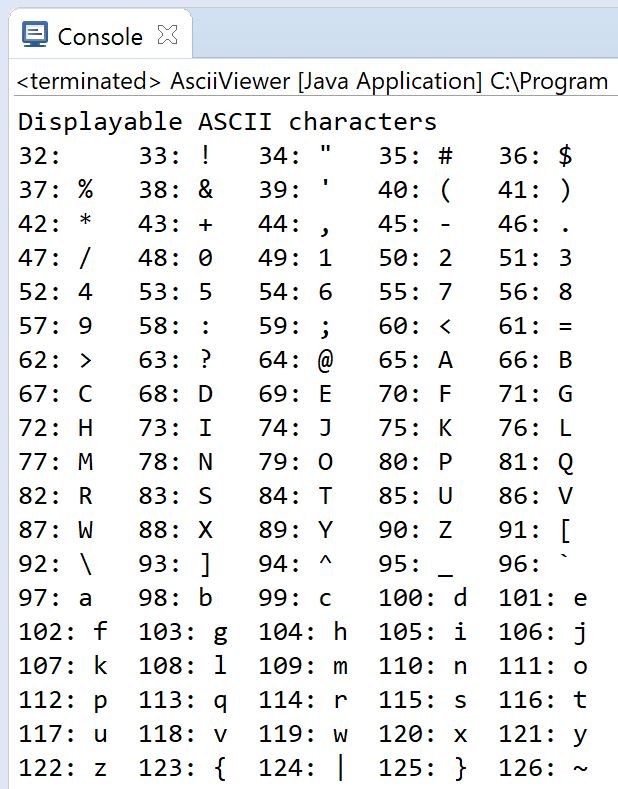

Thanks to its goal of including thousands of characters, it has become a popular choice for computer software. There are currently 143,859 characters, including historical scripts and emojis. The Universal Coded Character Set aims to provide a completely comprehensive code set for all characters. The numerous names for the code for northern European languages show that the information interchange code is continually changing as people develop more efficient systems.Ī fantastic example of these continual changes is the creation of Unicode.
#ASCII CODE FOR DIVISION SIGN ISO#
The extension, called the ISO 8859, has numerous language variations. The International Organization for Standardization (ISO) created the third section of the ASCII, including eight-bit codes. Since the ASCII contains mainly American characters, several variations with non-English letters developed around the world. Instead of copying and pasting those accented letters or unique currency signs, you can use this quick method not to break the flow of your typing. Nevertheless, it’s helpful to learn and understand ASCII-even if you aren’t interested in the technical details – so you can quickly get a foreign language letter whenever you need it.įor example, with Windows, you can press the ALT key and the given code to get any particular character. Whether you’ve realized it or not, you already use ASCII! Just using a computer system utilizes the ASCII.

The majority of computing systems still use ASCII, but new variations are becoming popular with specific systems. This third section includes characters from 128 to 255. In 1967, they added the first section of control characters and lowercase letters.įourteen years later, they implemented the extension group. The first meeting of the American Standard’s Association’s subcommittee X3.2 occurred in October 1960, and the members started with a teleprinter code from the Bell company.įrom there, they published the first version in 1963, which only had numbers and capital letters.

Sixty years ago, a conversation about creating a unified coding system for all types of characters began. Many foreign characters (like Á and Ö) fall into this category. The characters in this section vary depending on the particular operating system language you are using. The final section, ranging from character code 128 to 255, was a more recent addition.Įvery code has eight bits, each starting with one (as opposed to zero as in the previous two sections). In the next section, you’ll find the printable characters that occupy spaces 32 to 127.Īny character you see on the keyboard will be in this group, from the % symbol to the letters and numbers.Įven the spacebar and the delete key have their own codes (numbers 32 and 127, respectively). These unprintable numbers are only to control different external devices, like a keyboard or a printer. There are a total of 32 characters in this subgroup, labeled from 0 to 31. The first ASCII section is a control group that contains unprintable characters. To further organize these codes, the founders separated the characters into two sections, which later became three as people developed codes for more specialized characters. Instead of remembering the byte for each letter, symbol, and number, the founders organized them numerically and assigned them a decimal value.įor example, capital A (as mentioned above) is number 65, while the lowercase A is 97. Well, each byte in the standard ASCII starts with zero, so the following seven digits are those that differentiate the characters. If you counted how many digits there are, you might be confused about why there are eight digits instead of seven. This code is binary, so it only uses a combination of zeros and ones.įor example, the bits (binary digits) for a capital A are 01000001, while the bits for a lowercase A are 01100001. Essentially, it is the computer’s own language.Ĭomputers have a seven-digit code to represent each letter, number, and punctuation. ASCII ExplainedĪSCII stands for the American Standard Code for Information Interchange. You may know that computers use binary (combinations of the numbers zero and one) to store information, but how does that translate into the comprehensive text you read on your screen? Have you ever stopped to wonder how your computer works? Let’s get started! What Is ASCII in a Nutshell? So if you want to get the complete ASCII to decimal conversion table, then this article is for you. This ASCII to decimal table contains all 256 ASCII characters and their decimal counterparts. The complete ASCII to decimal conversion table.


 0 kommentar(er)
0 kommentar(er)
